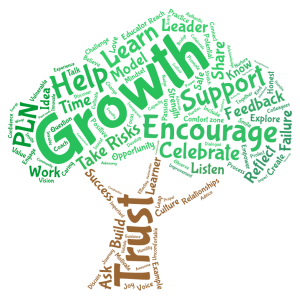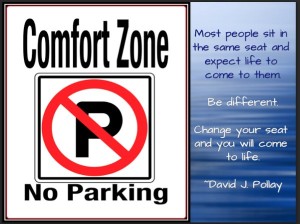Growth: Stepping Out of Our Comfort Zones
One of our graduates from the class of 2013 recently showed her work in an art exhibition called “Comfort”, which I was eager to see. Through photos and wooden sculptures Stephanie Logroño (see my interview with her in this post) explored the theme of the pain we ultimately feel when we fear change and stay in our comfort zone for too long. After admiring the artwork of this wunderkind (who obviously does not fear stretching herself beyond her comfort zone) I couldn’t stop thinking about all of the ramifications fear of change has on our lives.
Serendipitously, the very next day, the theme on my #leadupchat Twitter group was “growth” (I love it when life sends these messages). For an hour, educators tweeted about taking on challenges, accepting the discomfort that comes with learning and growing, and motivating others to take these steps. As I read their words, Stephanie’s artwork kept flashing into my mind… our safety nets eventually cut, like barbed wire, into our soul. Our comfort zone becomes a prison of our own making.
Change is such an integral part of life, and yet so many of us fear it and fight it. We tell ourselves that we’re fine just as we are, that we’ve “always done it like this,” and that things are “good enough.”
Growth is uncomfortable. And scary. So it’s tempting to get all cozy in our comfort zones, close our eyes, and pretend that everything is fine. But educators can’t afford this kind of complacency. WE may be just fine the way we are… but what about our students? When we ignore innovation, they lose out. On the other hand, when we take risks and try new things, we model a growth mindset for them and help them become lifelong learners.
So how do we find the courage to change and embrace growth? In the #leadupchat, the discussion was based on how leaders can support teachers as they grow. But I couldn’t help thinking back on my own first years as a teacher. There were no leaders that I could count on to support me. I’m sure there are many teachers out there who don’t have a great coordinator or coach to encourage them. How do we find the courage to change when we don’t have a strong support system?
I think most of the advice shared by the leaders in the chat can also be tweaked and used by teachers who feel somewhat alienated and alone in their profession. I popped all of the tweets into Tagul.com and made a word cloud of the most important ideas (feel free to print it and use those words to motivate you!). Then I took their advice on how to support others in their growth and modified it to become: how to support yourself in your own growth. Even if we work alongside great leaders, we should all learn to support our own development. I hope these ideas help you to not only feel more comfortable in your own process of growth, but to also eventually become a model for growth in others.
 Recognize your strengths – Too many teachers can tell me all about the areas they need to improve in, but when I ask, “ What do you do well?” they’re tongue-tied. Sit down and brainstorm every one of your strengths. Compliment yourself; encourage and motivate yourself. This is an extremely important first step, because you cannot build on the negative. Growth only comes from finding positive seeds and allowing them to flourish.
Recognize your strengths – Too many teachers can tell me all about the areas they need to improve in, but when I ask, “ What do you do well?” they’re tongue-tied. Sit down and brainstorm every one of your strengths. Compliment yourself; encourage and motivate yourself. This is an extremely important first step, because you cannot build on the negative. Growth only comes from finding positive seeds and allowing them to flourish.- Take small steps – Choose the area that you’d like to work on and begin small. For instance, if you decide to strengthen your relationships with your students’ parents, don’t decide to write a personal e-mail to all 90 of them in one evening (guess where that will get you?). Try writing five parents a week, but be consistent. Slowly, steadily, you will get there.
- Develop a growth mindset and embrace the power of risk-taking – Keep in mind that we can all change, but growth is hard and uncomfortable, so be compassionate with yourself. Give yourself support and encouragement. Do not judge or evaluate your efforts — rather, speak to yourself as a coach: “That was a good try. You did better than last time. Let’s try again.” Don’t give up after a failure. Practice and persistence will get you there.
- Learn to trust yourself – Trust is key to promoting growth. Believe in yourself, and believe in your ability to grow and change. Create a safe place for yourself to take the risks you need to grow, and trust that you will be kind to yourself.
- Reflect on your successes and failures – Talk to yourself the way you would talk to a friend. First of all, acknowledge what went well. Then think about the areas that didn’t work (and keep in mind that not everything will always work). There will be mistakes. But analyze what went wrong and see how you can do it differently next time. Remember, we learn more from our mistakes than from our accomplishments, so be grateful for them and use them as tools for growth. Then allow yourself to celebrate what went well. We all need a pat on the back and some positive reinforcement.
- Build relationships – Look for teachers who also want to grow, and build relationships with them. Maybe you won’t find them in your school… but in today’s world, that shouldn’t stop you from developing a community of learners. Read blogs, listen to inspiring podcasts, join a teacher Facebook group, and jump into some Twitter chats. Before you know it, you’ll have a PLN (personalized learning network). Be transparent about your weaknesses and where you need to grow. Develop trust by sharing your vulnerability. Be humble and willing to learn, and you’ll see how quickly your PLN supports you. Watch this video to better understand the power of being a connected educator – it’s truly life-changing!
Yes, growth and change are uncomfortable, but — as Stephanie reminds us — remaining in the comfort zone is so much worse (in the long term). Break your chains, step away from your old ways of doing things, and rise to your potential. It’s going to feel so good!



Great article. As in life, it’s much easier to stay on the safe side, however it’s so important for our students that we teach by example on how to take those steps out of the safety net and make the best out of it.
Thanks for reading Lorena! I agree, we can’t just ask our students to take risks, we have to model it constantly.
It is so hard sometimes to embrace change when we “think” we are just fine where we are. I’ve been taking small steps to leave my comfort zone, and as you mention, we have to take risks in order to grow. It is also hard to admit failure, it takes courage to accept your mistakes and learn from them.
Love this article and will definitely take your tips in consideration.
Personally, I see you as a huge risk taker, Ylonka! You’re the epitome of the life-long learner and one of my role models. 🙂